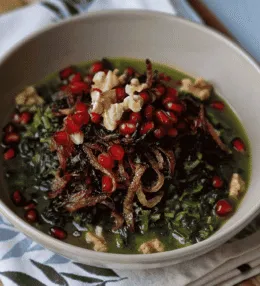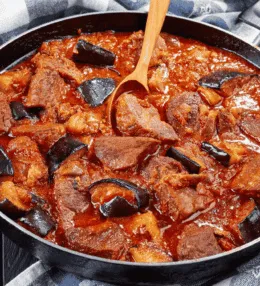
- View
Table of Contents
ToggleRotkohl, Germany’s beloved braised red cabbage dish, is a staple in German kitchens, known for its vibrant colour, tangy-sweet flavour, and versatility. Often served as a side dish to hearty meals, it brings a burst of brightness to plates filled with roasted meats and potatoes.
Slow cooked with apples, onions, and a delicate balance of spices, Rotkohl is more than just a complement, it’s a dish that holds its own, carrying a rich history and an unmistakable taste of German tradition.
Want to dive deeper into German Cuisine? Don’t miss our post on 33 Traditional German Foods to Try
What Is Rotkohl?
Rotkohl, which translates directly to “red cabbage,” is a classic German side dish that combines finely shredded red cabbage with apples, onions, and a touch of vinegar or wine for acidity.
This slow cooked dish transforms the humble cabbage into a tender, flavourful accompaniment that pairs beautifully with roasted meats like duck, pork, or beef. Its signature sweet and sour flavour is achieved through a careful balance of sugar and acid, often enhanced with spices like cloves, bay leaves, and juniper berries.
What makes Rotkohl so distinctive is its ability to bring harmony to rich and hearty meals. The acidity cuts through the fat of roasted meats, while its sweetness rounds out the dish, making it a perfect partner for traditional German fare.
The vibrant reddish purple hue, achieved through the reaction of the cabbage’s natural pigments with vinegar, adds a visual appeal that makes it a standout on any table.
Ingredients and Taste
Rotkohl is a simple dish made with a handful of ingredients. The key components are red cabbage, onions, and apples, which together form a base that is both earthy and slightly fruity.
A splash of vinegar or red wine provides acidity, which is balanced by a hint of sugar or honey. Spices like cloves, bay leaves, and sometimes juniper berries add subtle depth, creating a warm, aromatic backdrop for the other flavours.
The taste of Rotkohl is a delicate interplay between sweet and tangy. The cabbage becomes tender and slightly caramelized during cooking, while the apples add a gentle sweetness that complements the acidity of the vinegar.
The spices lend a cosy, almost festive note, making the dish feel special yet comforting. The result is a side dish that is flavourful but not overpowering, a true example of balance and restraint in German cooking.
A Taste of History
Rotkohl has been a part of German culinary tradition for centuries, with its origins rooted in the need to preserve vegetables through the winter months.
Cabbage, being both hardy and abundant, became a staple ingredient in many German households, and recipes like Rotkohl showcased the ingenuity of cooks who transformed this humble vegetable into something exceptional.
The addition of vinegar and spices not only enhanced the flavour but also acted as natural preservatives, ensuring the dish could be enjoyed even during the colder months.
The dish’s association with hearty, celebratory meals reflects its place in German culture as a staple of holiday feasts and family gatherings. Served alongside roast goose or pork, it’s a dish that has graced tables during Christmas and other festive occasions for generations.
The inclusion of apples and spices is thought to have been influenced by trade routes that brought exotic flavours to Europe, adding depth and variety to traditional recipes.
How to Make Rotkohl (German Red Cabbage)
Rotkohl is a cherished German side dish that brings a balance of sweet and sour flavours to the table. It pairs beautifully with roast meats, sausages, or dumplings and gains depth from slow simmering with apples, onions, and spices. Expect tender, glossy strands of cabbage infused with warmth and gentle acidity. See the recipe card at the bottom for printable directions
Ingredients
- 1 medium red cabbage (about 900 g), finely shredded
- 2 tbsp unsalted butter
- 1 medium onion, finely chopped
- 1 large tart apple, peeled and grated (such as Bramley or Granny Smith)
- 3 tbsp red wine vinegar
- 100 ml red wine
- 150 ml apple juice or water
- 2 tbsp soft brown sugar
- 1 bay leaf
- 3 whole cloves
- 1 small cinnamon stick
- Salt and freshly ground black pepper, to taste
Cooking Instructions
Step 1: Prepare the cabbage
Remove any coarse outer leaves from the red cabbage and slice it finely using a sharp knife or mandoline. Place it in a large bowl and toss gently to separate the strands for even cooking.
Step 2: Sauté the aromatics
In a large heavy-based pot, melt the butter over medium heat. Add the chopped onion and sauté until soft and translucent. This builds a sweet foundation for the dish.
Step 3: Add apple and spices
Stir in the grated apple, bay leaf, cloves, and cinnamon stick. Allow the mixture to cook for a minute or two until fragrant. The apple provides natural sweetness and helps balance the vinegar added later.
Step 4: Combine the cabbage
Add the shredded cabbage to the pot and stir thoroughly so it is well coated in the butter and aromatics. Cook for about 5 minutes, letting the cabbage begin to soften slightly before adding liquids.
Step 5: Add liquids and seasoning
Pour in the red wine vinegar, red wine, and apple juice. Stir in the brown sugar, then season lightly with salt and pepper. The combination of wine and vinegar gives the dish its signature sweet-sour depth.
Step 6: Simmer gently
Cover the pot with a tight-fitting lid and reduce the heat to low. Simmer for about 45 minutes, stirring occasionally to ensure even cooking. The cabbage should become tender but still hold its shape.
Step 7: Adjust seasoning
Taste the cabbage near the end of cooking. Add a little more sugar or vinegar if needed to adjust the balance between sweetness and tang. Remove the bay leaf, cinnamon stick, and cloves.
Step 8: Finish and rest
Let the Rotkohl sit for 10 minutes after cooking to allow the flavours to deepen further. It often tastes even better the next day after resting overnight.
Step 9: For serving
Serve warm alongside roast pork, duck, sausages, or beef. It also pairs wonderfully with mashed potatoes or bread dumplings. Garnish with a small knob of butter for a glossy finish before serving.
Variations and Substitutions
- Fruit variation: Replace the apple with pear for a softer sweetness.
- Vinegar substitute: Use cider vinegar if red wine vinegar is unavailable.
- Wine substitute: Omit the wine and increase the apple juice for an alcohol-free version.
- Spice alternative: A pinch of allspice or nutmeg can replace the cloves if preferred.
Cooking Tips for Perfect Rotkohl
- Allow the cabbage to cook slowly for tender texture and deep colour.
- Avoid over-stirring, which can break down the strands and make it mushy.
- Resting overnight enhances the flavour, making it richer and more harmonious.
- For extra gloss, stir in a teaspoon of butter just before serving.

German Rotkohl (Red Cabbage)
Equipment
- Large knife or mandolin slicer
- Large mixing bowl
- Heavy bottomed pot with lid
- Wooden spoon or spatula
Ingredients
- 1 medium red cabbage about 900 g, finely shredded
- 2 tbsp unsalted butter
- 1 medium onion finely chopped
- 1 large tart apple peeled and grated (such as Bramley or Granny Smith)
- 3 tbsp red wine vinegar
- 100 ml red wine
- 150 ml apple juice or water
- 2 tbsp soft brown sugar
- 1 bay leaf
- 3 whole cloves
- 1 small cinnamon stick
- Salt and freshly ground black pepper to taste
Instructions
- Remove any coarse outer leaves from the red cabbage and slice it finely using a sharp knife or mandoline. Place it in a large bowl and toss gently to separate the strands for even cooking.
- In a large heavy-based pot, melt the butter over medium heat. Add the chopped onion and sauté until soft and translucent. This builds a sweet foundation for the dish.
- Stir in the grated apple, bay leaf, cloves, and cinnamon stick. Allow the mixture to cook for a minute or two until fragrant. The apple provides natural sweetness and helps balance the vinegar added later.
- Add the shredded cabbage to the pot and stir thoroughly so it is well coated in the butter and aromatics. Cook for about 5 minutes, letting the cabbage begin to soften slightly before adding liquids.
- Pour in the red wine vinegar, red wine, and apple juice. Stir in the brown sugar, then season lightly with salt and pepper. The combination of wine and vinegar gives the dish its signature sweet-sour depth.
- Cover the pot with a tight-fitting lid and reduce the heat to low. Simmer for about 45 minutes, stirring occasionally to ensure even cooking. The cabbage should become tender but still hold its shape.
- Taste the cabbage near the end of cooking. Add a little more sugar or vinegar if needed to adjust the balance between sweetness and tang. Remove the bay leaf, cinnamon stick, and cloves.
- Let the Rotkohl sit for 10 minutes after cooking to allow the flavours to deepen further. It often tastes even better the next day after resting overnight.
- Serve warm alongside roast pork, duck, sausages, or beef. It also pairs wonderfully with mashed potatoes or bread dumplings. Garnish with a small knob of butter for a glossy finish before serving.
Nutrition
You May Also Like






